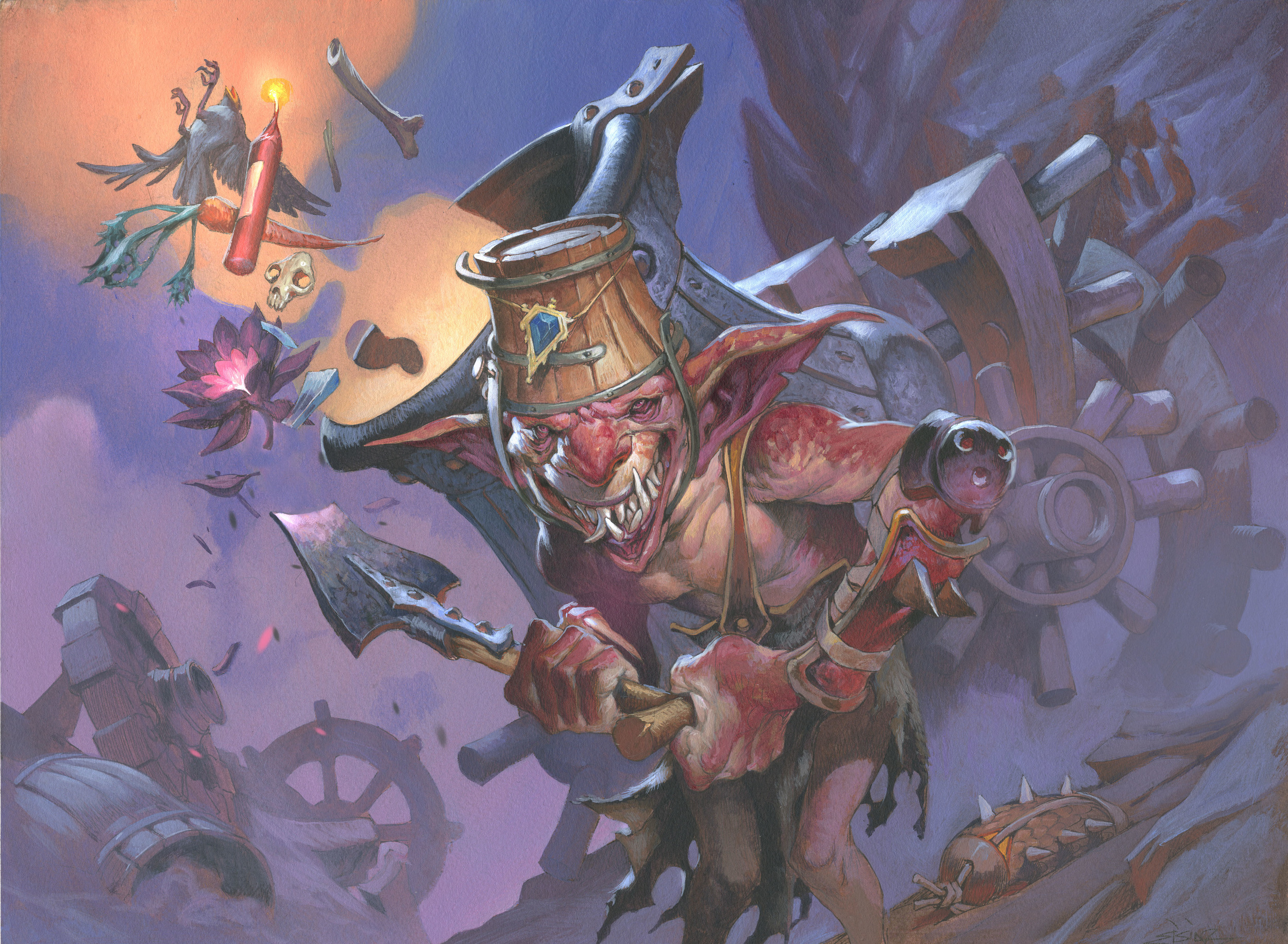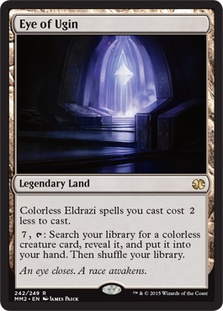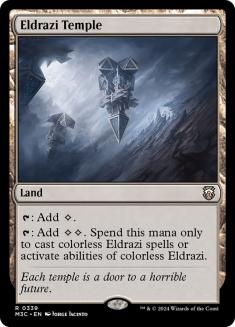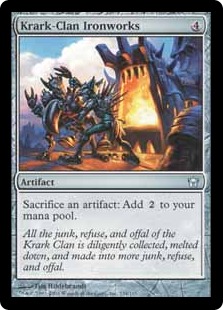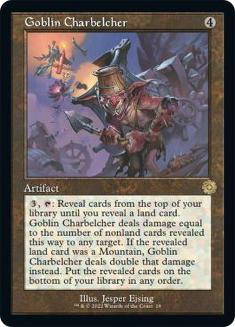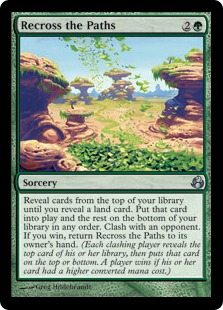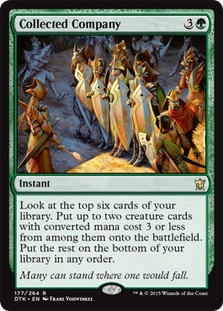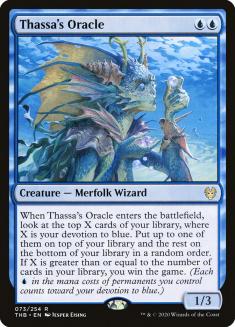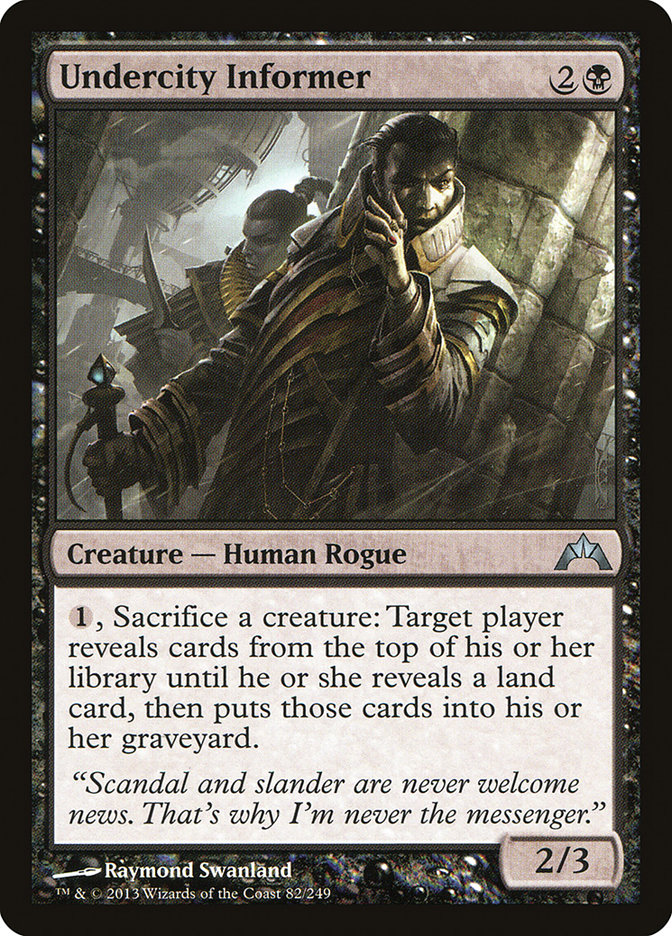Magic is a game with a rich and varied history. Over the 27 years that the game has existed, there have been a great number of cards printed with unique effects that make sense during the context of their time period. However, as we have seen time and again, the same does not necessarily hold true when combining them with cards printed many years later.
Eye of Ugin and Eldrazi Temple are stellar examples of this effect, as they were originally printed to help cast the massive Eldrazi spells from Rise of the Eldrazi, but later became totally unfair when combined with cards like Reality Smasher and Thought-Knot Seer from Oath of the Gatewatch.
Krark-Clan Ironworks was played in a few mediocre combo decks for many years before Scrap Trawler created a powerful engine that took it into the stratosphere (though, to be fair, Mox Opal did a lot of the heavy lifting!).
Even Stoneforge Mystic wasn’t a tremendously overpowered card when it first saw print, because it wasn’t picking up the broken Equipment that would arrive over the next year. Once Sword of Feast and Famine saw print, it turned into a superstar and Batterskull pushed it to ban-worthy.
The same thing has now happened to a peculiar artifact from 2003, Mirrodin‘s Goblin Charbelcher.
Now, Goblin Charbelcher has a rich history as a nonsensical combo piece for decks that jump through some strange hoops. It’s the namesake card of the Legacy Belcher combo deck, which eventually settled on one land, a Taiga, as the only land in the whole deck. It’s gone through a number of iterations over the last fifteen years or so, but the most recent popular version looks something like this:
Spells (47)

In Modern, on the other hand, which exists without as much preposterous fast mana as Legacy, Goblin Charbelcher has never been more than an extremely fringe part of the metagame. In a multi-year tournament career, a Modern player might play against Goblin Charbelcher once or twice in some Magic Online (MTGO) Leagues, and even then it would likely be because the opponent was recording the League for amusement or streaming purposes.
It simply was not feasible to construct a deck that consistently generated seven mana and found a win condition in Goblin Charbelcher or Empty the Warrens without playing at least a few real mana-producing lands. After the second or third land, though, Charbelcher becomes awfully dicey as an actual win condition, and so there’s little incentive to try to make it a legitimate deck.
Zendikar Rising changes all of that in a flash. And it’s all because the modal double-faced cards (DFCs). Now a 24-land deck can actually run zero land cards, which makes Goblin Charbelcher uniquely powerful as an instant win. The deck can reasonably win as early as Turn 2, with two lands, two copies of either Desperate Ritual or Pyretic Ritual, an Irencrag Feat, and a Goblin Charbelcher.
There are a number of different builds of the deck out there, but the first person to break this design out was Sebastian Stückl, who sent the following screenshot on Twitter last week and started a firestorm.
Creatures (8)
Spells (52)
- 4 Desperate Ritual
- 4 Goblin Charbelcher
- 4 Recross the Paths
- 4 Manamorphose
- 4 Pyretic Ritual
- 1 Reforge the Soul
- 3 Vessel of Volatility
- 4 Veil of Summer
- 4 Irencrag Feat
- 4 Valakut Awakening
- 4 Bala Ged Recovery
- 4 Spikefield Hazard
- 4 Shatterskull Smashing
- 4 Turntimber Symbiosis
Sideboard

There are a number of incredible innovations worth your attention in this deck, aside from the obvious combo between lands-that-aren’t-really-lands and Goblin Charbelcher.
Recross the Paths is an obscure uncommon from Morningtide, a small set from twelve years ago that contained more notable cards like Bitterblossom and Vendilion Clique. But here, the fact that Recross the Paths digs through your deck looking for a land, then tells you to put the rest on the bottom of your library “in any order,” means that you get to stack your deck. That’s right, you pay three mana and order your library however you want. Do you have four mana and an Irencrag Feat, and just need a Goblin Charbelcher to cast? Make your next four draw steps all Charbelchers! Do you have the Charbelcher and the fourth mana source, but need three more to win on the fourth turn immediately? Give yourself the gift of an Irencrag Feat topdeck!
Did you get Thoughtseized to death, have no cards in your hand, and just need to gas up again? A single copy of Reforge the Soul can do the trick! And of course, out of the sideboard, a few peculiar one-ofs offer a totally different win condition for a mere five mana. Why are Collected Company, Thassa’s Oracle, and Undercity Informer in this deck’s sideboard? Stack your deck and find out!
It’s not that convoluted, actually. The idea is that you cast Recross the Paths and place Collected Company on top of your library. Somewhere in the six cards beneath it, you put Thassa’s Oracle and Undercity Informer. At that point, you have the win set up. You cast Collected Company, putting both creatures on the battlefield. With Thassa’s Oracle’s trigger on the stack, you can sacrifice the Undercity Informer and mill your entire library. Then you win! Exciting, isn’t it?
This sideboard inclusion allows you to pull out a win with access to less total mana than Goblin Charbelcher requires. Discounting the three mana needed to set it up with Recross the Paths, Goblin Charbelcher requires seven mana over two turns, while this Collected Company interaction requires five mana over one turn. If you need to win the game by Turn 4, but you only have one Simian Spirit Guide or Desperate Ritual effect and no Goblin Charbelcher, you may find spots where the Collected Company combo is the answer you need to steal victory from the jaws of defeat.
As a bonus, this combo can be run at the end of your opponent’s turn. If you have access to a lot of mana, you can stack your deck with a Collected Company above a Goblin Charbelcher, with the two creatures next in line. Then, you’ll be able to threaten an instant-speed win, but if the opponent counters the Company, you just calmly peel a Charbelcher right off the top and win with that one on your own turn. The utility from this single interaction with Recross the Paths is impressive.
A card that lets you choose the order of your library is tremendously abusable, and it appears that the DFCs have turned a second weird old card into a Modern powerhouse.
There also has to be consideration given to the fact that a number of the spell-lands in this deck are actually legitimate spells in their own right! There’s no rule saying you can’t use your Spikefield Hazard to exile an opposing Noble Hierarch or Thalia, Guardian of Thraben, or that you can’t cast your Valakut Awakening to dig for one of your power cards if your hand is full of useless fast mana effects. There also isn’t anything preventing you from casting Tangled Florahedron on Turn 2 in order to run out a Goblin Charbelcher on Turn 3 against a deck without a lot of creature removal. The DFCs do have front sides for a reason!
Goblin Charbelcher has a rich history as a nonsensical combo piece for decks that jump through some strange hoops.
Now, there is an unfortunate downside to the DFCs. It’s minor, but it exists. Your opponent can Thoughtseize your land in this format. If Grixis Death’s Shadow takes your second land with a Thoughtseize, you’re going to be a sad individual. This is not usually going to be relevant, but it is meaningful in a significant number of games.
Understandably, this first crack at a new archetype has taken Modern by storm, but there’s always refinement to be made. In the age of rapid iteration on MTGO, the deck has already seen a number of variations that offer a more multi-pronged approach to the gameplan.
An even newer different build of the deck that maindecks the Blood Moons appeals to me in a number of ways. Why? Blood Moon actually benefits this deck by turning all of its tapped DFCs into untapped Mountains. That’s wonderful news! Simultaneously, it hurts opposing decks, especially the Amulet Titan decks and the multicolor piles that try to incorporate Cryptic Command. In the current Modern metagame, I generally prefer maindecking the Blood Moon and sideboarding Veil of Summer, rather than vice versa.
One can even push the envelope and attempt to blend the power of Goblin Charbelcher with the lockdown elements from various Mono-Red Prison decks. Chalice of the Void; Blood Moon; and Karn, the Great Creator all have unique appeal in a deck like this by offering different types of “one-hit KO” effects against different portions of the metagame. Suddenly instead of winning with Goblin Charbelcher, you can “win” the game against Grixis Death’s Shadow by landing a first-turn Chalice of the Void or a second-turn Blood Moon.
Here’s one example of that:
Creatures (7)
Spells (53)

Depending on how much of the sideboard one wants to devote to a Karn, the Great Creator “Wishboard,” one could easily incorporate that, too. Karn finds Goblin Charbelcher, Ensnaring Bridge, Defense Grid, Tormod’s Crypt, and more.
One could also take a page out of the Legacy playbook and try to play with Empty the Warrens as an alternate win condition. It’s reasonable to expect eight to ten Goblins on an early turn, though it’s unclear if that would be good enough to actually win the game against many decks in the format. A lot of people are packing combos of their own!
To be honest, these new DFCs and their interactions with these spells from over a decade ago resemble “real-life software bugs.” There’s no way any of this was intentional on the part of Wizards of the Coast (WotC), but these things happen when you have a rich history of unique cards that constantly try to push boundaries in your game in order to keep it fresh and exciting.
I’m personally expecting this archetype to become a feature of a number of formats for the foreseeable future, but would not be surprised to find a number of bans stemming from the interactions that these new DFCs produce. But hey, if it gets me to pick up a Chalice of the Void / Blood Moon deck for the first time in my life, I’ll consider this innovative design decision by the Play Design team to be a fun and worthwhile, if short-lived, experiment.

